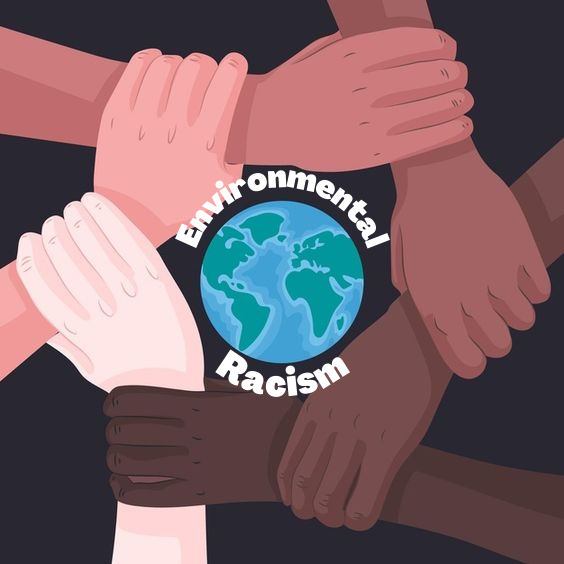Let’s face it…racism is part of everyday life…It is a facet of a many-sided prism, extended to many aspects of our daily living. Now that climate justice has been discussed, environmental racism in on the spotlight. The term first appeared in 1982 from African American civil rights leader Benjamin Chavis. Generally, environmental racism as a word is used as a form of inequality.
According to the World Economic Forum [1] environmental racism is “a form of systemic racism whereby communities of colour are disproportionately burdened with health hazards through policies and practices that force them to live in proximity to sources of toxic waste such as sewage works, mines, landfills, power stations, major roads and emitters of airborne particulate matter”. In simpler words, it is the disproportionate effects of burden of the environmental hazards to people of colour and low socioeconomic background communities. Nevertheless, Lancet Planetary Health (2018) [2] includes in the definition ethnic and religious minorities. Consequently, the abovementioned communities are more vulnerable towards hazardous pollutants, living close to pollution.
Environmental justice means that no community should be saddled with more environmental burdens and less environmental benefits than any other.
Majora Carter
According to the World Economic Forum, globalization amplifies the effects of environmental racism on an international scale. Imagine all the e-wastes (i.e., electrical wastes) that are dumped in the global south by the global north due to more flexible laws and legislation. These wastes are toxic if not disposed properly due to the toxins that release when they disintegrate.
In February 2018, a study conducted by Environmental Protection Agency [3] concluded that minority and low-income communities are disproportionately affected by air pollution compared to the overall population. To put that into perspective, the study shows that people of colour face a 28% higher health burden due to the fact that they live near facilities that emit particulate pollution, such as soot.
Examples of environmental racism
Environmental racism can take numerous forms. It can include workplaces with unsound health regulations or coal power plant, landfills or toxic dump sites installed near non-white or low-income communities. It can also include people living in decaying buildings that are contaminated with asbestos (a contaminant linked to cancer [4]) or water of low quality with a plethora of contaminants, such as lead (a neurotoxin linked to difficulties in the development of the brain). The abovementioned factors affect the well-being and health (mental and physical) of minorities.
Environmental justice is the fair treatment and meaningful involvement of all people regardless of race, color, national origin, or income, with respect to the development, implementation, and enforcement of environmental laws, regulations, and policies. This goal will be achieved when everyone enjoys the same degree of protection from environmental and health hazards, and equal access to the decision-making process to have a healthy environment in which to live, learn, and work.
Environmental Protection Agency
Environmental Privilege
Maybe you have heard about white privilege or male privilege. In 1989 Peggy McIntosh published a paper called “White Privilege: Unpacking the Invisible Knapsack” defining what is white privilege, posing some critical questions for self-evaluation.
Lievanos (2010) [5] defines environmental privilege as “the taken-for-granted structures, practices, and ideologies that give a social group disproportionately high level of access to environmental benefits”. Furthermore, sociologists Pellow and Brehm (2013) [6] claim that “environmental privilege allows access to coveted amenities, such as forests, parks, green space, healthy food, coastal properties, and elite neighborhoods”. According to the abovementioned authors, environmental privilege is the opposite side of environmental justice (Pellow and Brehm, 2013).
In order to understand what environmental privilege is and based on McIntosh’s paper, the following questions are for better understanding and self-evaluation for people living in wealthy countries. You can ask yourself “is that true for me?”.
- I use as much water as I choose in my everyday activities (bathing, cooking etc.) without thinking about it.
- I consume fruits and vegetables that are not grown in the region that I live.
- The temperature of my home is controlled by me based on my own comfort.
- My trash are thrown away in a great distance from my home.
- I drink clean water.
- I can if I wish to reduce my carbon footprint by driving a hybrid vehicle.
- I can choose to live in a neighborhood where many local services and shops are accessible in a walking distance or by bicycling.
- In my mind, environmental destruction constitute a future threat rather than an ongoing disaster.
- I can choose to spend time outdoors only when the weather is agreeable.
- I can adopt an uncompromising attitude about the protection of ecosystems & wild land habitat without worrying that my own livelihood will be threatened or that I will be unable to access the products I use in my daily life.
How many of these questions apply to your life?
Environmental racism as well as environmental privilege are inextricably linked and are subjects that are now beginning to receive attention. Further scientific research is mandatory.
References
[1] https://www.weforum.org/agenda/2020/07/what-is-environmental-racism-pollution-covid-systemic/
[2] Lancet Planetary Health (2018): Environmental Racism: Time to Tackle Social Injustice. Lancet 2(11), e462, https://doi.org/10.1016/S2542-5196(18)30219-5
[5] Lievanos, R. (2010). A Minority Perspective is Limited: Environmental Privilege and Surface Water Hazards in an Impaired Estuary. In annual meeting of the Association of American Geographers, April (Vol. 18).
[6] Pellow, D. N., & Brehm, H. N. (2013). An environmental sociology for the twenty-first century. Annual Review of Sociology, 39(1), 229-250.
